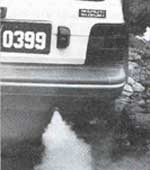Vehicles of radiation
 Radioactivity should be added to the list of potential carcinogens in motor-vehicle exhausts, say scientists from the University of Bristol, UK. Denis Henshaw and colleagues have found raised concentrations of radioactive polonium-210 in the environment and in the teeth of children living up to 10 km from the country's busy motorways (The Lancet, Vol 345, No 8945).
Radioactivity should be added to the list of potential carcinogens in motor-vehicle exhausts, say scientists from the University of Bristol, UK. Denis Henshaw and colleagues have found raised concentrations of radioactive polonium-210 in the environment and in the teeth of children living up to 10 km from the country's busy motorways (The Lancet, Vol 345, No 8945).
Measurements showed that polonium concentration was almost 20 times higher on these motorways than in central Bristol. The findings are surprising because they are not obscured by the closeness of major urban areas, where the concentration of this radioactive substance is also high.
Polonium-210, which was found in association with lead-210, can come from leaded petrol or from its presence in oil as a decay product from tiny amounts of uranium-238. Excess polonium-210 is absorbed by bone, liver, and kidneys.
At the levels detected, polonium-210 cannot be linked with any certainty to cancer. However, it could be a potential carcinogen, judging from studies linking high levels of naturally-occurring radon gas, another radioactive source, to leukaemia, brain tumours and kidney cancer, particularly in children.
Related Content
- Reducing black carbon emissions from diesel vehicles: impacts, control strategies, and cost-benefit analysis
- India State of the Environment Report : The Monthly Overview, September 2013
- Capital’s air quality monitoring best
- CSE assesses air quality and mobility initiatives in Indian cities
- WHO declares diesel fumes cause lung cancer
- Mobile tower radiation, chemicals held for sparrow disappearance
